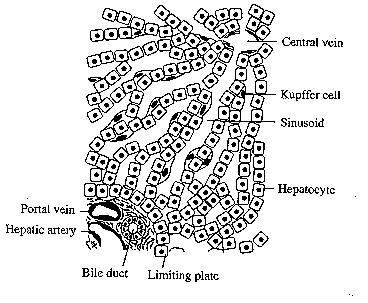
 Regenerative Capacity
Regenerative Capacity

![]() Hepatocytes rarely divide, but they have a unique capacity to reproduce
in response to an appropriate stimulus, such as the removal of a portion
of liver.This process involves controlled hyperplasia, or increased cell
division, that usually restores the liver to within 5 to 10% of its original
weight. Hepatic injury or partial removal leads to both systemic (e.g.,
in the blood and other tissues) and local (within the liver) release of
growth factors that stimulate hepatocyte replication.
Hepatocytes rarely divide, but they have a unique capacity to reproduce
in response to an appropriate stimulus, such as the removal of a portion
of liver.This process involves controlled hyperplasia, or increased cell
division, that usually restores the liver to within 5 to 10% of its original
weight. Hepatic injury or partial removal leads to both systemic (e.g.,
in the blood and other tissues) and local (within the liver) release of
growth factors that stimulate hepatocyte replication.



 Because
all hepatocytes can perform the necessary hepatic functions and all have
an equal ability to replicate, the liver can undergo compensatory growth
and restore its size. Liver regeneration plays an important role after
surgical removal of a portion of liver (partial hepatectomy) and after
injuries that destroy portions of the liver, such as viral, toxic, or ischemic
damage. However, excessive damage can reach a "point of no return," and
normal tissue will be replaced with scar tissue. The liver's ability to
regenerate is also compromised by pre-existing or repeated liver damage
or disease.
Because
all hepatocytes can perform the necessary hepatic functions and all have
an equal ability to replicate, the liver can undergo compensatory growth
and restore its size. Liver regeneration plays an important role after
surgical removal of a portion of liver (partial hepatectomy) and after
injuries that destroy portions of the liver, such as viral, toxic, or ischemic
damage. However, excessive damage can reach a "point of no return," and
normal tissue will be replaced with scar tissue. The liver's ability to
regenerate is also compromised by pre-existing or repeated liver damage
or disease.
![]()